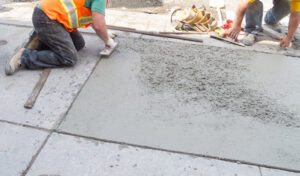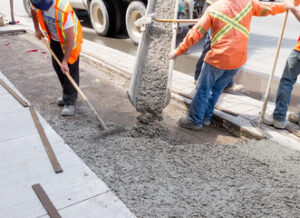Concrete Repair can extend structures’ lifespan and reduce replacement costs. It requires intelligent evaluation of the structure, identification of the cause(s) of deterioration or distress, and selection of appropriate repair methods and materials.
Surface repairs can correct problems such as honeycombing, sand streaking, form joint offsets, and surface wear. However, they must be competently placed, cured, and acceptably finished. Visit Website to learn more.
Routing and sealing cracks is an industry-wide technique for repairing minor and major asphalt pavement cracks. It can be applied in a recessed or flush fill application to reduce the depth of the crack and help protect traffic, pedestrian and snow plow contact. It can also be used to prevent infiltration of water, chlorides and other contaminants that can be carried from the subgrade into the concrete parking deck surface. Although this method does not provide a structural repair it can significantly extend the life of the concrete.
Typically a hot liquified rubber sealant is used for this type of repair. The cracks should be routed and cleaned prior to this to ensure that all of the crevice is exposed. This will allow for proper bonding between the liquified rubber and the side walls of the crack. When this repair is done without routing the cracks the liquified rubber is only able to penetrate the top surface of the cracked concrete. As a result, the cracks will often re-open as the temperature of the concrete fluctuates throughout the year.
For concrete surfaces that are not subject to significant service loads or movement, routing and sealing may be the most cost effective method of extending the life of your concrete parking lot slabs. This treatment is generally performed during the spring and fall months when temperatures are moderate to cool. This allows the liquified rubber to be placed into the crack and accommodate movement in the summer and winter.
Another repair method that can extend the life of your concrete is epoxy injection. This consists of placing a surface cap of non-sag epoxy over the crack and installing injection ports in drilled holes at close intervals along horizontal, vertical or overhead cracks and pressure injecting epoxy into the cracks. With the exception of moisture tolerant epoxies, this type of repair does not restore as-designed strengths nor does it resolve load-carrying capacity or safety concerns.
The key to a successful epoxy injection job is in the preparation of the concrete. The contractor should fully remove the existing traffic coating system down to clean bare concrete using grinding or scarifying methods and thoroughly clean the cracks. This will ensure that the cracks are not filled with dust or debris which can cause adhesion failure between the injected epoxy and the concrete surface. Then the cracks should be routed to a predefined geometry and treated with an approved polyurethane sealant such as Tremco’s Dymonic 100. This should be properly tool and allowed to cure.
Stitching
A concrete repair job often involves more than just patching or filling cracks in the surface of existing concrete. In some cases, structural repairs are needed to fix a problem such as a collapsed basement or a structural beam that is no longer supporting a load-bearing wall. The goal of any concrete repair project is to restore the strength, integrity and durability of the structure in question.
For structural repairs that require shoring or other means to support the structure, it is important to have good communication with a general contractor. It is also necessary to understand the type of construction project you are working on and what factors will influence how your work will be performed. For instance, if the structure is located outside, it is likely to be exposed to extreme weather conditions that can impact the concrete’s performance over time.
The best method to use for stitching cracks in concrete structures depends on the cause of the cracking and how deep it extends. If the crack is primarily caused by drying shrinkage, then it may stabilize over time, but more significant structural problems will need to be addressed.
If the crack is deeper and requires a more permanent solution, it is recommended that a structural engineer be consulted for guidance. Structural engineers are knowledgeable in the design of concrete and the physics that govern how structures are loaded during service. In addition, structural engineers are familiar with building codes and can help ensure that the repairs meet local code requirements for structural safety.
To begin a structural repair, the crack must be cleaned and prepared. It is essential to remove any dirt or debris that could impede the bond of the new concrete to the old. Once the area has been cleaned, a bonding agent must be applied to the concrete surface. The bonding agent can be applied with a brush, rag, or sprayer, but direct application is the most effective way to ensure that it is fully absorbed.
Once the bonding agent has been applied, it is time to apply the concrete patch. It is best to use a product that sets quickly, such as Fast Setting Cement Patcher. This product can be mixed by hand or with a power mixer, but mixing with a gloved hand is most convenient for small patches. Once the material has been applied, a margin trowel is used to shape it into the desired corner and rod it out to eliminate air bubbles.
Filling Cracks
Concrete repair involves a broad range of techniques, and the method used depends on the situation. Ultimately, the most effective repairs are those that address all of the factors contributing to the deterioration of the concrete structure: drainage issues, excessive water pressures, soil settlement issues, cracking due to stresses and tensions, and so on.
Stitching is a technique for repairing structural concrete cracks by using U-shaped metal bars of different lengths placed across the cracked surface. This creates a “twist” in the crack that helps to spread the stress load more evenly. This is typically a more permanent repair method than filling cracks.
Before starting the actual concrete repair, contractors must prepare the surface to ensure that the new material will bond properly with the existing concrete. Depending on the type of concrete, this preparation may involve scrubbing and washing, brushing or vacuuming, or a combination of these. Contractors must also identify any structural problems with the concrete that should be addressed in the repair, such as delaminations. These can be identified by pinging the concrete surface with a hammer; sounding areas of delamination should produce a dull, hollow sound as opposed to the hard ring that comes from sound concrete.
Once the concrete is clean and prepared, a repair mix can be troweled into the cracks and broken area to replace the damaged concrete. It is important to follow the manufacturer’s directions for mixing and applying the product. Failing to do so can lead to the cracking and disbonding of the repair.
After a successful application, it is often a good idea to skim coat the repaired area with Sakrete Top ‘N Bond to achieve a more uniform appearance and to protect against re-cracking. It is also a good idea to cover the repaired area with plastic and mist it periodically to help ensure that the repair will cure correctly.
It is best to leave major structural repairs to an experienced concrete contractor. A professional will be able to diagnose the root cause of the problem and determine the best course of action for a lasting repair.
Sealing Over Cracks
When repairing concrete cracks, you can use several methods. The most common is routing and sealing which involves widening the crack and filling it with an appropriate sealant. While more commonly used for dormant cracks, this method may also be applied to active ones if the proper materials are chosen.
Experts say the first step is cleaning out the cracks and making sure they are free of loose material that could prevent a good bond. This is especially critical for narrow cracks as they can develop a tendency to back out of the crack. If the cracks are deep, you will want to clean them to make sure all of the concrete is exposed and free of debris.
Using a hand sledge and mason chisel, you will need to knock out any weak or brittle material in the crack that would prevent a strong new bond. Do this on both sides of the crack, and be careful not to chip too much and create a weakness in the concrete. The goal is to expose a fresh surface along the crack for a new bond to form, and this will help prevent the crack from recurring.
Once you have cleaned the cracks and removed any loose material, you will need to sand or brush down the cracked areas to remove any dust, dirt or debris that might prevent a good bond. You will also want to undercut the repair area by saw cutting into the concrete at a slight angle. This will mechanically lock the repair to the concrete and avoid a gap when you pour the sealant.
Bagged concrete mix manufacturers design their repair products with safety regulations in mind such as removing silica and making the materials easier to mix. Many also add admixtures that help resist cracking, and some even incorporate fibers into the concrete for reinforcement. This can help increase a concrete’s flexural strength and flexibility to reduce the chance of future cracking.
When you’re ready to apply the sealant, use a margin trowel to spread the material and smooth it as needed. Once the concrete has been shaped, anchor a piece of plastic to keep the repair dry until it’s cured. For best results, a flexible urethane or silicone sealant is recommended. These types of products provide greater load-carrying capacity and crack edge support than latex based products. They will also require a chemical solvent such as acetone to remove after application, but they will last longer.



 Concrete repair is an important maintenance task for various structures, including buildings, bridges, parking garages, and sidewalks. Repairing damaged concrete can help prevent further deterioration and extend the structure’s lifespan. Professional
Concrete repair is an important maintenance task for various structures, including buildings, bridges, parking garages, and sidewalks. Repairing damaged concrete can help prevent further deterioration and extend the structure’s lifespan. Professional